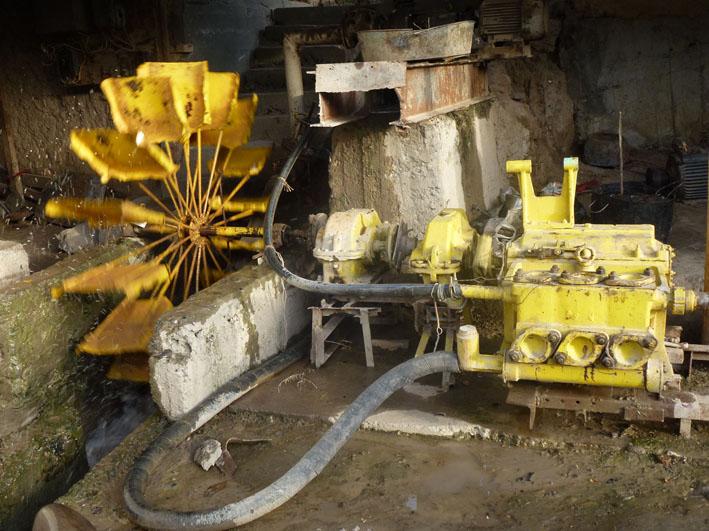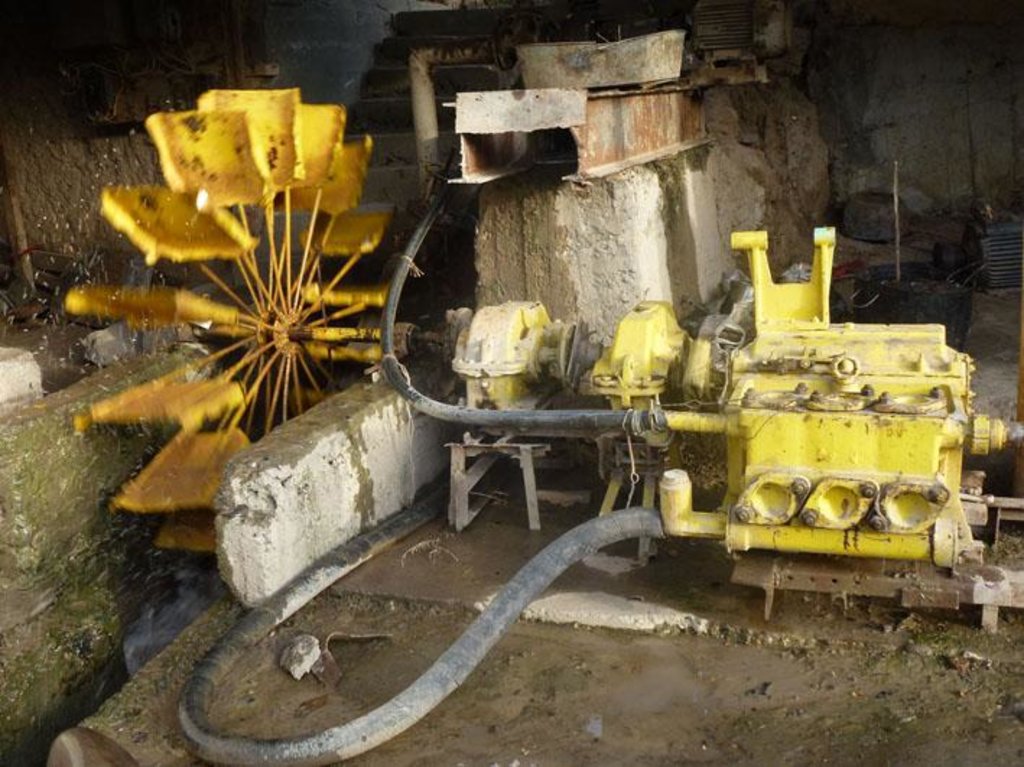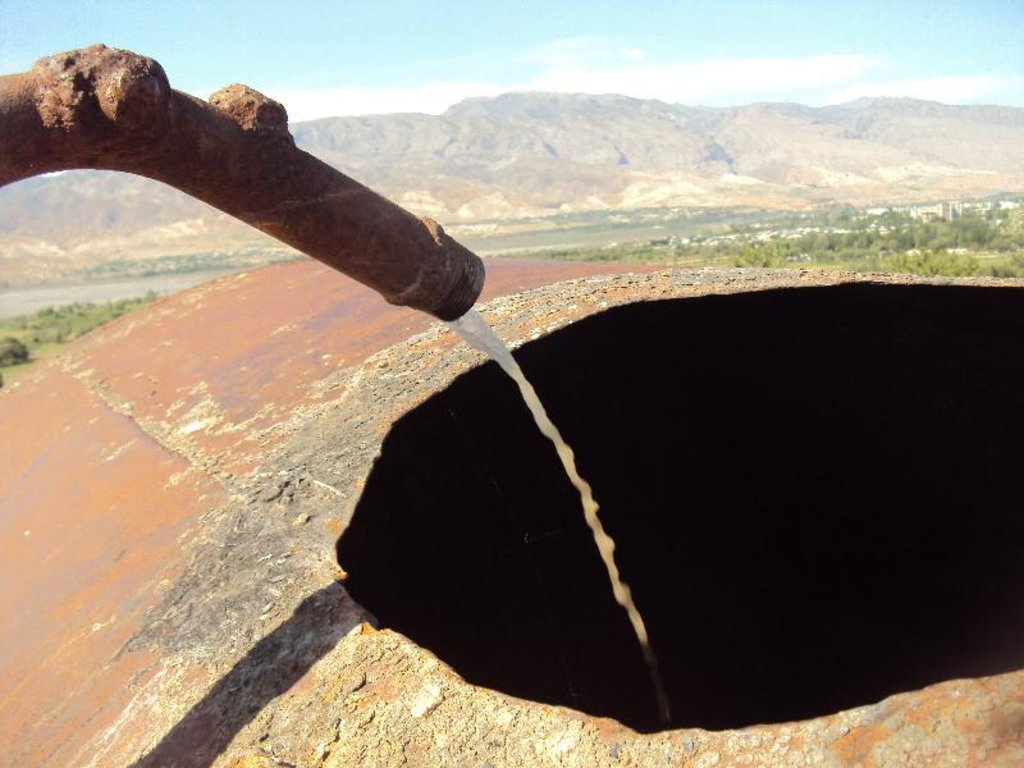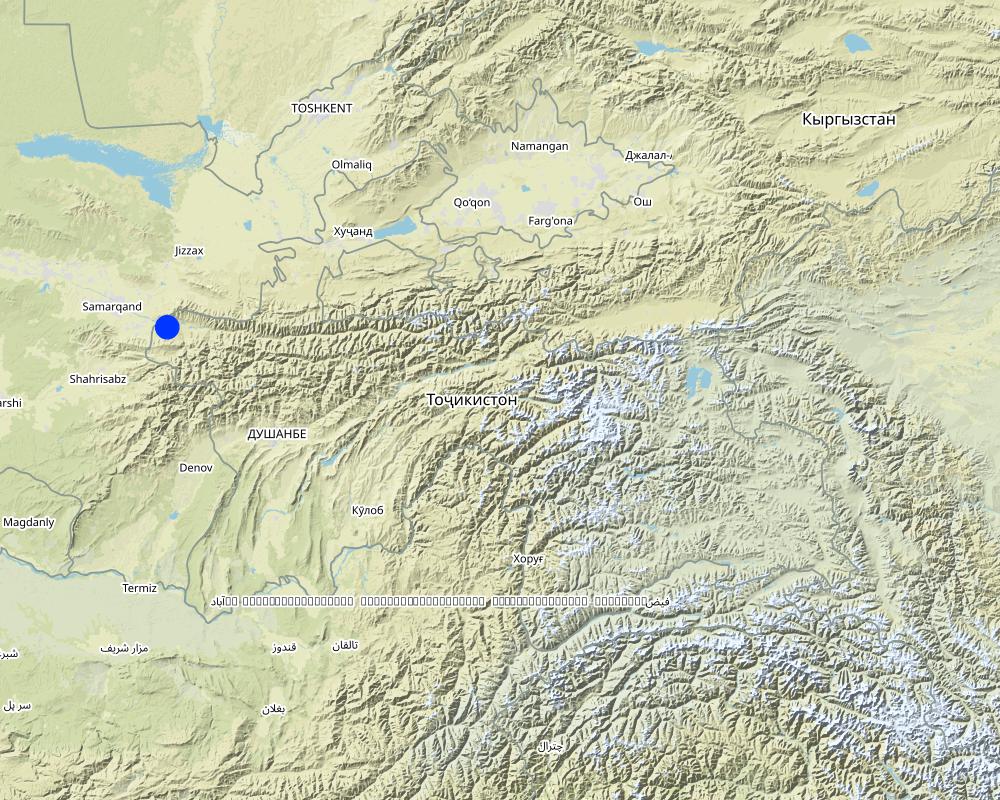Water wheel pump system [Tajikistan]
- Creation:
- Update:
- Compiler: Sa'dy Odinashoev
- Editor: –
- Reviewers: Alexandra Gavilano, David Streiff, Joana Eichenberger
technologies_1051 - Tajikistan
View sections
Expand all Collapse all1. General information
1.2 Contact details of resource persons and institutions involved in the assessment and documentation of the Technology
Name of project which facilitated the documentation/ evaluation of the Technology (if relevant)
Pilot Program for Climate Resilience, Tajikistan (WB / PPCR)Name of the institution(s) which facilitated the documentation/ evaluation of the Technology (if relevant)
CARITAS (Switzerland) - SwitzerlandName of the institution(s) which facilitated the documentation/ evaluation of the Technology (if relevant)
NCCR North-South (NCCR North-South) - Kyrgyzstan1.3 Conditions regarding the use of data documented through WOCAT
The compiler and key resource person(s) accept the conditions regarding the use of data documented through WOCAT:
Yes
2. Description of the SLM Technology
2.1 Short description of the Technology
Definition of the Technology:
A water wheel that powers a pump that provides water to an orchard further upslope.
2.2 Detailed description of the Technology
Description:
After the end of the Soviet era the mass irrigation system fell into disrepair, and many of the orchard areas subsequently suffered from dehydration and production levels declined. The case study plot is situated on a steep slope of 50° with stone/sand soils with high filtration rates.
As the irrigation systems no longer worked, the orchard in the Penjikent area lost much productivity and became very dry. As the quality of the soil is very poor the trees need much irrigation. The farmer often resorted to using a bucket to irrigate the orchards.
The land user developed a water powered pump using the flow from the existing river to pump water along a plastic pipe to the orchards. The pump can irrigate the orchard 200m above the river level. To help improve the process and regulate irrigation amount a large tank was installed in the orchard.
Purpose of the Technology: The purpose of the pump is to provide water 220m upslope to irrigate the orchards at minimal running costs, and not to be reliant on the often intermittent electricity supply.
Establishment / maintenance activities and inputs: The setting up the water wheel, pump, gear system, valves and piping system requires a certain level of technical knowledge. However, it is apparent that if you have a fast flowing river, water can be diverted to power a water wheel and a pump. Technical knowledge of the gearing will be required set up the ratios depending on the speed required for the water wheel.
Natural / human environment: In this area the very sandy soil, suffers from high infiltration rates and low water retention capacity. It is, therefore, unfavourable for growing any sort of water dependent crops. The water pump, albeit expensive in its initial financial expenditure does allow for irrigation of land, that would otherwise become increasingly denuded and degraded. The demise of the Soviet irrigation system means that the land users have had to invent and discover new innovative ways to irrigate the land.
2.3 Photos of the Technology
2.5 Country/ region/ locations where the Technology has been applied and which are covered by this assessment
Country:
Tajikistan
Region/ State/ Province:
Sughd
Further specification of location:
Penjakent, Toshminor
Specify the spread of the Technology:
- evenly spread over an area
If precise area is not known, indicate approximate area covered:
- < 0.1 km2 (10 ha)
Comments:
This technology was developed by an individual in the region.
Map
×2.6 Date of implementation
If precise year is not known, indicate approximate date:
- 10-50 years ago
2.7 Introduction of the Technology
Specify how the Technology was introduced:
- through land users' innovation
3. Classification of the SLM Technology
3.1 Main purpose(s) of the Technology
- improved access to irrigation
3.2 Current land use type(s) where the Technology is applied

Grazing land

Forest/ woodlands
- Tree plantation, afforestation
Tree plantation, afforestation: Specify origin and composition of species:
- Monoculture local variety
Products and services:
- Fuelwood
- Fruits and nuts
- Nature conservation/ protection
Comments:
Livestock density (if relevant):
50-100 LU /km2
Major land use problems (compiler’s opinion): The land is very highly degraded, there is also limited vegetation due to the poor water supply
Major land use problems (land users’ perception): The land was very highly degraded and the soil condition was very poor.
Plantation forestry: mainly orchards
Forest products and services: fuelwood, fruits and nuts, nature conservation / protection
Future (final) land use (after implementation of SLM Technology): Cropland: Ct: Tree and shrub cropping
3.3 Has land use changed due to the implementation of the Technology?

Grazing land

Forest/ woodlands
3.4 Water supply
Water supply for the land on which the Technology is applied:
- full irrigation
Comments:
Number of growing seasons per year:
1
Specify:
Longest growing period in days: 220Longest growing period from month to month: March - October
3.5 SLM group to which the Technology belongs
- irrigation management (incl. water supply, drainage)
- energy efficiency technologies
3.6 SLM measures comprising the Technology

agronomic measures
- A2: Organic matter/ soil fertility

vegetative measures
- V1: Tree and shrub cover

structural measures
- S11: Others

management measures
- M1: Change of land use type
Comments:
Main measures: structural measures
3.7 Main types of land degradation addressed by the Technology

soil erosion by water
- Wt: loss of topsoil/ surface erosion

chemical soil deterioration
- Cn: fertility decline and reduced organic matter content (not caused by erosion)

biological degradation
- Bc: reduction of vegetation cover
Comments:
Main type of degradation addressed: Wt: loss of topsoil / surface erosion, Bc: reduction of vegetation cover
Secondary types of degradation addressed: Cn: fertility decline and reduced organic matter content
Main causes of degradation: Irrigation system (Water was not available for reafforestation.)
Secondary causes of degradation: change in temperature, change of seasonal rainfall, droughts (lack of rainfall is the main contributor to the degradation of the land.), war and conflicts
3.8 Prevention, reduction, or restoration of land degradation
Specify the goal of the Technology with regard to land degradation:
- restore/ rehabilitate severely degraded land
Comments:
Secondary goals: prevention of land degradation, mitigation / reduction of land degradation
4. Technical specifications, implementation activities, inputs, and costs
4.1 Technical drawing of the Technology
Technical specifications (related to technical drawing):
Technical knowledge required for land users: high (The design of the pump needs technical input.)
Main technical functions: water harvesting / increase water supply, water spreading
Secondary technical functions: improvement of ground cover, improvement of surface structure (crusting, sealing), increase in organic matter, increase of infiltration
Mulching
Material/ species: grass from the plot
Quantity/ density: 3 sm
Structural measure: water pump
4.2 General information regarding the calculation of inputs and costs
Specify currency used for cost calculations:
- USD
Indicate average wage cost of hired labour per day:
5.55
4.3 Establishment activities
| Activity | Timing (season) | |
|---|---|---|
| 1. | Construction of water pump | any |
4.4 Costs and inputs needed for establishment
| Specify input | Unit | Quantity | Costs per Unit | Total costs per input | % of costs borne by land users | |
|---|---|---|---|---|---|---|
| Labour | Construction of water pump | Persons/day | 20.0 | 5.55 | 111.0 | 100.0 |
| Construction material | Machine parts | for 1 pump | 1.0 | 50.0 | 50.0 | 100.0 |
| Construction material | Welding rod | for 1 pump | 1.0 | 5.0 | 5.0 | 100.0 |
| Construction material | Drilling pump | for 1 pump | 1.0 | 1200.0 | 1200.0 | 100.0 |
| Construction material | Gear system | for 1 pump | 1.0 | 200.0 | 200.0 | 100.0 |
| Construction material | Valve gates | for 1 pump | 1.0 | 25.0 | 25.0 | 100.0 |
| Construction material | Stone | for 1 pump | 1.0 | 220.0 | 220.0 | 100.0 |
| Construction material | Pipes | for 1 pump | 1.0 | 1035.0 | 1035.0 | 100.0 |
| Construction material | Tank | for 1 pump | 1.0 | 500.0 | 500.0 | 100.0 |
| Total costs for establishment of the Technology | 3346.0 | |||||
| Total costs for establishment of the Technology in USD | 3346.0 | |||||
4.6 Costs and inputs needed for maintenance/ recurrent activities (per year)
Comments:
Costs are based upon 2010 prices.
4.7 Most important factors affecting the costs
Describe the most determinate factors affecting the costs:
The initial set up costs are quite high, but the actual operating costs are minimal.
5. Natural and human environment
5.1 Climate
Annual rainfall
- < 250 mm
- 251-500 mm
- 501-750 mm
- 751-1,000 mm
- 1,001-1,500 mm
- 1,501-2,000 mm
- 2,001-3,000 mm
- 3,001-4,000 mm
- > 4,000 mm
Agro-climatic zone
- semi-arid
Thermal climate class: temperate
5.2 Topography
Slopes on average:
- flat (0-2%)
- gentle (3-5%)
- moderate (6-10%)
- rolling (11-15%)
- hilly (16-30%)
- steep (31-60%)
- very steep (>60%)
Landforms:
- plateau/plains
- ridges
- mountain slopes
- hill slopes
- footslopes
- valley floors
Altitudinal zone:
- 0-100 m a.s.l.
- 101-500 m a.s.l.
- 501-1,000 m a.s.l.
- 1,001-1,500 m a.s.l.
- 1,501-2,000 m a.s.l.
- 2,001-2,500 m a.s.l.
- 2,501-3,000 m a.s.l.
- 3,001-4,000 m a.s.l.
- > 4,000 m a.s.l.
Comments and further specifications on topography:
Landforms: Also valles floors
5.3 Soils
Soil depth on average:
- very shallow (0-20 cm)
- shallow (21-50 cm)
- moderately deep (51-80 cm)
- deep (81-120 cm)
- very deep (> 120 cm)
Soil texture (topsoil):
- coarse/ light (sandy)
Topsoil organic matter:
- low (<1%)
If available, attach full soil description or specify the available information, e.g. soil type, soil PH/ acidity, Cation Exchange Capacity, nitrogen, salinity etc.
Topsoil organic matter: Soil is very degraded
Soil fertility is very low
Soil drainage / infiltration is good
Soil water storage capacity is very low
5.4 Water availability and quality
Ground water table:
> 50 m
Availability of surface water:
poor/ none
Water quality (untreated):
good drinking water
Comments and further specifications on water quality and quantity:
Ground water table: The higher up the slope the deeper the water table.
5.5 Biodiversity
Species diversity:
- low
5.6 Characteristics of land users applying the Technology
Market orientation of production system:
- subsistence (self-supply)
Off-farm income:
- less than 10% of all income
Relative level of wealth:
- poor
- average
Individuals or groups:
- individual/ household
Level of mechanization:
- manual work
Gender:
- men
Indicate other relevant characteristics of the land users:
Land users applying the Technology are mainly Leaders / privileged
Population density: 10-50 persons/km2
Annual population growth: 1% - 2%
10% of the land users are rich.
40% of the land users are average wealthy.
30% of the land users are poor.
20% of the land users are poor.
Off-farm income specification: Many people are interested in adopting of the technology.
5.7 Average area of land used by land users applying the Technology
- < 0.5 ha
- 0.5-1 ha
- 1-2 ha
- 2-5 ha
- 5-15 ha
- 15-50 ha
- 50-100 ha
- 100-500 ha
- 500-1,000 ha
- 1,000-10,000 ha
- > 10,000 ha
Is this considered small-, medium- or large-scale (referring to local context)?
- medium-scale
5.8 Land ownership, land use rights, and water use rights
Land ownership:
- state
Land use rights:
- leased
- Throgh association
Water use rights:
- open access (unorganized)
- Throgh association
5.9 Access to services and infrastructure
health:
- poor
- moderate
- good
education:
- poor
- moderate
- good
technical assistance:
- poor
- moderate
- good
employment (e.g. off-farm):
- poor
- moderate
- good
markets:
- poor
- moderate
- good
energy:
- poor
- moderate
- good
roads and transport:
- poor
- moderate
- good
drinking water and sanitation:
- poor
- moderate
- good
financial services:
- poor
- moderate
- good
6. Impacts and concluding statements
6.1 On-site impacts the Technology has shown
Socio-economic impacts
Production
crop production
wood production
risk of production failure
production area
land management
Water availability and quality
water availability for livestock
irrigation water availability
Income and costs
expenses on agricultural inputs
workload
Socio-cultural impacts
SLM/ land degradation knowledge
Livelihood and human well-being
Comments/ specify:
Timber and fruit production has increased on the irrigated land.
Ecological impacts
Water cycle/ runoff
water quantity
water quality
harvesting/ collection of water
Soil
soil moisture
soil cover
soil crusting/ sealing
6.2 Off-site impacts the Technology has shown
water availability
buffering/ filtering capacity
6.3 Exposure and sensitivity of the Technology to gradual climate change and climate-related extremes/ disasters (as perceived by land users)
Gradual climate change
Gradual climate change
| Season | increase or decrease | How does the Technology cope with it? | |
|---|---|---|---|
| annual temperature | increase | well |
Climate-related extremes (disasters)
Meteorological disasters
| How does the Technology cope with it? | |
|---|---|
| local rainstorm | well |
| local windstorm | well |
Climatological disasters
| How does the Technology cope with it? | |
|---|---|
| drought | well |
Hydrological disasters
| How does the Technology cope with it? | |
|---|---|
| general (river) flood | well |
Comments:
In the winter months, the pipe may become frozen and split. The pipe could be insulated to help prevent this happening.
6.4 Cost-benefit analysis
How do the benefits compare with the establishment costs (from land users’ perspective)?
Short-term returns:
slightly positive
Long-term returns:
very positive
How do the benefits compare with the maintenance/ recurrent costs (from land users' perspective)?
Short-term returns:
slightly positive
Long-term returns:
very positive
6.5 Adoption of the Technology
- single cases/ experimental
If available, quantify (no. of households and/ or area covered):
1 household
Of all those who have adopted the Technology, how many did so spontaneously, i.e. without receiving any material incentives/ payments?
- 91-100%
Comments:
100% of land user families have adopted the Technology without any external material support
There is a little trend towards spontaneous adoption of the Technology
Comments on adoption trend: Many farmers and projects are interested in implementing the technolgy in the future.
6.7 Strengths/ advantages/ opportunities of the Technology
| Strengths/ advantages/ opportunities in the land user’s view |
|---|
| Has improved their livelihood considerably, feel more secure. |
| Strengths/ advantages/ opportunities in the compiler’s or other key resource person’s view |
|---|
|
An increase in the production of wood, fruit and timber. How can they be sustained / enhanced? More training on tree cultivation techniques. |
| Decrease in the workload, previously the trees were irrigated using a bucket |
| The quality of the soil has increased with a reduction in crusting of the surface due to drying out. |
6.8 Weaknesses/ disadvantages/ risks of the Technology and ways of overcoming them
| Weaknesses/ disadvantages/ risks in the land user’s view | How can they be overcome? |
|---|---|
| Took some time to pay for all materials |
| Weaknesses/ disadvantages/ risks in the compiler’s or other key resource person’s view | How can they be overcome? |
|---|---|
| High initial cost. | Loans could be made available. |
| High level of technical knowledge required to construct and maintain. | Training could be provided to interested personnel. |
7. References and links
7.1 Methods/ sources of information
Links and modules
Expand all Collapse allLinks
No links
Modules
No modules





